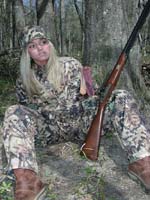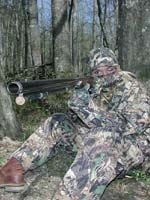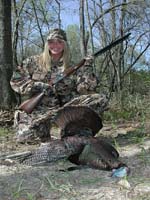
|
Features
|
|
|
|
Books
|
|
|
|
Fun & Games
|
|
|
|
Contact Us
|
|
|
John's Journal... Entry 86, Day 1
Speake's Turkey Research in the Early Years
 EDITOR'S
NOTE: For more than 43 years, Dr. Dan Speake has researched wildlife.
He has studied turkeys for almost four decades, beginning his love affair
with the wild turkey in 1966. Retired as the leader of the Cooperative
Research Unit at Auburn University in Auburn, Alabama, he now teaches
at Auburn University. A very knowledgeable researcher and turkey hunter,
Speake tells us about some of his findings that have increased everyone's
knowledge of wild turkeys and helped to expand the population of the wild
turkey.
EDITOR'S
NOTE: For more than 43 years, Dr. Dan Speake has researched wildlife.
He has studied turkeys for almost four decades, beginning his love affair
with the wild turkey in 1966. Retired as the leader of the Cooperative
Research Unit at Auburn University in Auburn, Alabama, he now teaches
at Auburn University. A very knowledgeable researcher and turkey hunter,
Speake tells us about some of his findings that have increased everyone's
knowledge of wild turkeys and helped to expand the population of the wild
turkey.
 Since
I've learned after all my research that no one can know everything about
turkeys, I still consider hunting turkeys one of the greatest challenges
in all the outdoors. I love to hunt turkeys just as much as I did the
first day I saw my first wild turkey. Every October I begin to swim and
run to get in shape for the upcoming spring turkey season.
Since
I've learned after all my research that no one can know everything about
turkeys, I still consider hunting turkeys one of the greatest challenges
in all the outdoors. I love to hunt turkeys just as much as I did the
first day I saw my first wild turkey. Every October I begin to swim and
run to get in shape for the upcoming spring turkey season.
In the early days of turkey research, we biologists were very interested in learning what factors limited the growth of the turkey population. We also wanted to know what caused turkeys to move, what habitat requirements they had, and what their natural mortality rate was.
 We
used a new technique for capturing turkeys that quickly replaced the cannon
nets researchers once used. We started drugging turkeys to facilitate
the capture-and-release process. We tagged the turkeys with brightly colored,
numbered streamers to aid us in spotting and identifying individual turkeys.
We
used a new technique for capturing turkeys that quickly replaced the cannon
nets researchers once used. We started drugging turkeys to facilitate
the capture-and-release process. We tagged the turkeys with brightly colored,
numbered streamers to aid us in spotting and identifying individual turkeys.
In this time before radio telemetry, I wore camouflage clothing and used binoculars every day for several years to try and learn everything I could about the wild turkeys we'd tagged. Then after three or four years, Auburn University became one of the first research facilities to use radio telemetry to keep up with the movements of wild turkeys. We gained another big advantage in our research when radio telemetry became so compact we could attach it to three-to-five-day-old poults and monitor their movements and mortality. At Auburn, we learned important facts about turkeys that helped to promote the spread of wild turkeys throughout the nation and also taught me more about how to hunt turkeys.
 But
I've also learned that studying the land is as critical to learning where
to find turkeys as studying the birds themselves. By reading turkey signs
and tracking turkeys, you often can determine what a turkey will do and
where he'll go before he does.
But
I've also learned that studying the land is as critical to learning where
to find turkeys as studying the birds themselves. By reading turkey signs
and tracking turkeys, you often can determine what a turkey will do and
where he'll go before he does.
To learn more about hunting turkeys, go back to Night Hawk's home page, and click on books. You'll find information there on three turkey-hunting books written by John E. Phillips that contain interviews with some of the nation's top turkey hunters. Then call (800) 627-4295 to receive a brochure or to order a book.
TOMORROW: Why Turkeys Vanish
Check back each day this week for more about What I've Learned In Almost Four Decades Of Studying Turkeys ...
Day 1 -Speake's Turkey Research
in the Early Years
Day 2 -Why Turkeys Vanish
Day 3 -Where Turkeys Live
Day 4 -What Hunting Pressure Does to Turkeys
Day 5 -How Fast Turkey Populations Grow